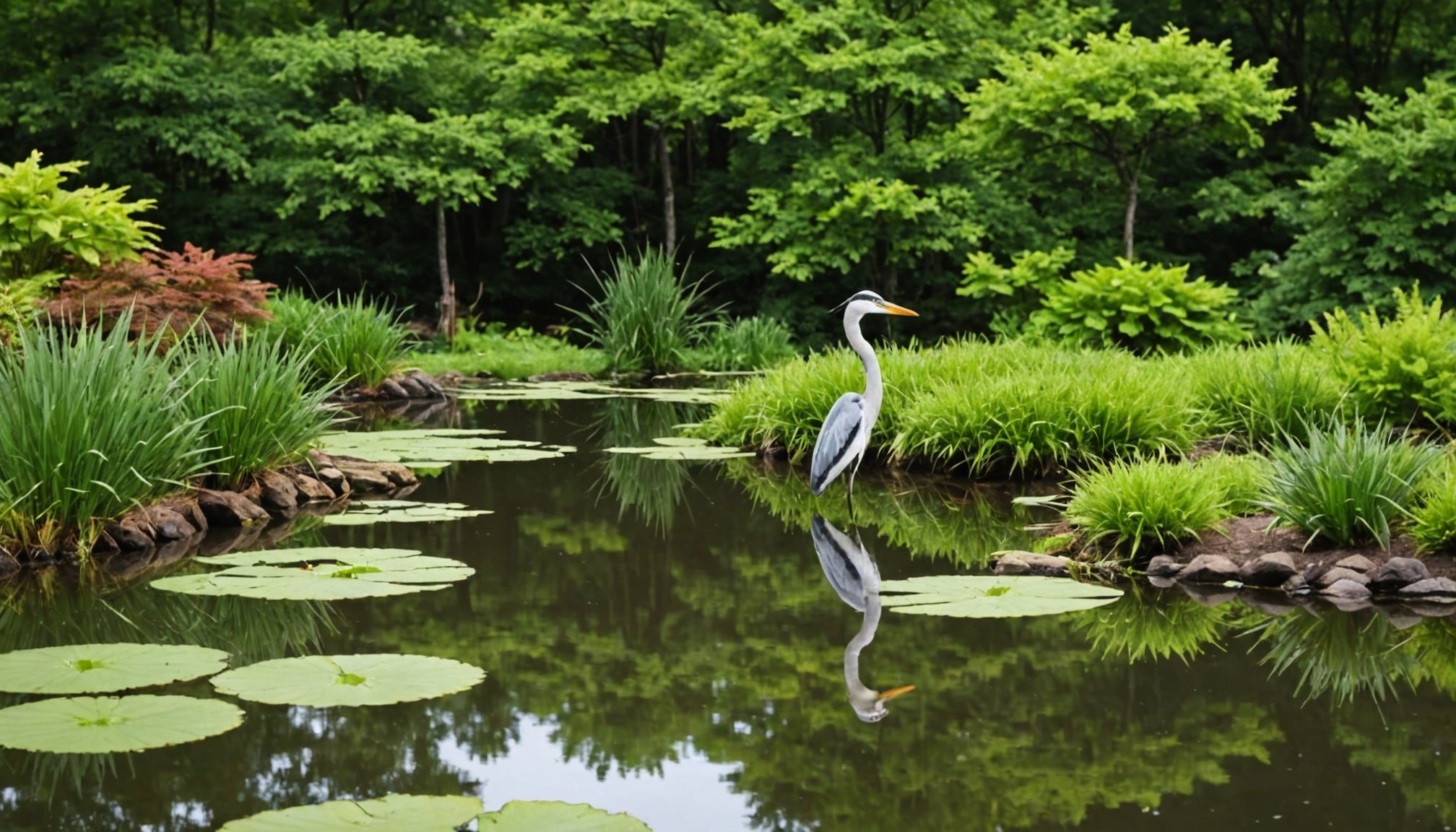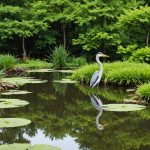Protecting your fish pond from herons and other predatory threats requires proactive strategies. These birds can quickly diminish your fish population, leaving you frustrated. Implementing deterrents, creating a safe environment, and using natural barriers can help safeguard your aquatic haven. Explore innovative solutions tailored to keep herons and other predators at bay while allowing your fish to thrive. Empower yourself with these effective methods for a sustainable and serene pond experience.
Understanding Heron Behavior and Threats to Fish Ponds
Exploring the intricate dynamics of heron behavior and its impact on fish ponds.
Cela peut vous intéresser : Crafting a Safe and Stimulating Indoor Cat Garden: A Creative Guide for Feline Wellness
Heron Feeding Habits
Herons are predatory birds known for their patience and precision when hunting. They often stand still in shallow waters, waiting to strike unsuspecting fish. Their diet primarily consists of fish, making them a significant threat to fish ponds. Herons use their long necks and sharp beaks to catch prey with remarkable accuracy.
Common Predators of Fish Ponds
Fish ponds face numerous threats from various predators. Besides herons, other common predators include raccoons, otters, and larger birds of prey. These creatures are attracted to the abundance of fish and can quickly deplete pond populations if left unchecked.
Avez-vous vu cela : Essential Tips for Detecting and Preventing Flystrike in Outdoor Rabbits During Humid Conditions
- Herons: Stealthy hunters, primarily targeting fish.
- Raccoons: Opportunistic feeders, often raid ponds at night.
- Otters: Skilled swimmers, can decimate fish stocks rapidly.
Impact of Predatory Threats on Fish Populations
The presence of predatory birds and other creatures can significantly affect fish populations in ponds. Fish may become stressed, reducing their growth rates and reproduction. Effective management strategies are crucial to mitigate these threats and maintain a balanced ecosystem. Understanding heron behavior and the broader spectrum of fish pond threats is essential for protecting aquatic life and ensuring a thriving pond environment.
Physical Barriers for Pond Protection
Implementing effective strategies to safeguard fish ponds from predatory threats.
Types of Fencing Suitable for Fish Ponds
Pond protection can be effectively achieved through various physical barriers. Fencing is a common choice, offering a robust solution to deter predators. Options include wire mesh, which is durable and can be tailored to fit any pond size. Electric fences provide an additional deterrent, delivering a mild shock to ward off intruders.
Netting and Mesh Options to Deter Birds
For those specifically targeting birds like herons, netting and mesh options are essential. Lightweight netting can be stretched over the pond, creating a barrier that prevents birds from reaching the water. Mesh with small openings is particularly effective, as it stops even the most persistent herons from accessing fish.
Designing Barriers That Blend with the Landscape
While ensuring pond protection, it's important to consider aesthetics. Designing physical barriers that blend seamlessly with the landscape enhances the pond's appearance. Natural materials like wooden posts or green-coated mesh can be used to complement the surrounding environment.
- Wire Mesh: Durable and customizable
- Electric Fences: Effective deterrent
- Lightweight Netting: Ideal for bird prevention
Implementing these physical barriers not only secures fish ponds but also maintains a visually pleasing environment.
Utilizing Decoys and Scare Tactics
Exploring innovative methods to deter predators effectively.
Effective Decoys to Mimic Natural Predators
Decoys can play a pivotal role in protecting fish ponds. By mimicking natural predators, decoys create an environment that herons and other predators perceive as threatening. A well-placed decoy, such as a plastic owl or alligator head, can deter herons by simulating the presence of a predator. It's important to move these decoys periodically to maintain their effectiveness.
Sound and Visual Scare Tactics That Work
Scare tactics utilize both sound and visual elements to create an unwelcoming atmosphere for predators. Devices like motion-activated sprinklers or ultrasonic sound emitters can startle herons, raccoons, and other threats. Visual deterrents, such as reflective tape or predator eyes, add another layer of protection by disorienting potential intruders.
Rotating Deterrents for Continued Effectiveness
To prevent predators from becoming accustomed to deterrents, it's crucial to rotate them regularly. This strategy keeps the deterrents unpredictable and effective. Consider using a combination of decoys, sound devices, and visual elements, altering their positions and types every few weeks. This approach ensures that your predator deterrents remain a formidable barrier against unwanted visitors.
- Plastic Owl: Mimics natural predator
- Motion-Activated Sprinklers: Startles intruders
- Reflective Tape: Disorients potential threats
Implementing a dynamic system of decoys and scare tactics can significantly enhance the security of your fish pond.
Strategic Planting Around the Pond
Enhancing pond security through thoughtful landscaping.
Best Plants to Deter Herons and Other Predators
Incorporating aquatic plants around your pond can serve as a natural deterrent to herons and other predators. Tall grasses and reeds create a physical barrier, making it difficult for herons to spot and access fish. Dense vegetation like cattails and bulrushes offers excellent coverage, discouraging predators from approaching.
Creating a Natural Barrier with Vegetation
By strategically planting aquatic plants, you can establish a natural barrier that enhances pond security. Not only do these plants obstruct predators’ views, but they also provide shelter for fish, reducing stress. Consider using native plants, which are well-adapted to local conditions and require minimal maintenance. This approach supports ecosystem balance and boosts biodiversity.
Benefits of Native Plants for Ecosystem Balance
Native plants play a crucial role in maintaining a healthy pond ecosystem. They offer habitat for beneficial insects and contribute to water quality by filtering pollutants. Additionally, native species are more resilient to local pests and diseases, ensuring a sustainable environment.
- Cattails: Provide cover and deter predators
- Bulrushes: Create a dense barrier
- Native Plants: Support biodiversity and ecosystem health
Incorporating a variety of aquatic plants not only deters herons but also enhances the overall health and beauty of your pond.
Enhancing Water Movement and Noise
Exploring how water dynamics can protect your pond.
Installing Water Features to Disrupt Hunting
Water movement is a crucial factor in deterring predators like herons. Installing dynamic water features, such as fountains or waterfalls, can disrupt the serene surface of a pond, making it difficult for herons to hunt effectively. The constant movement not only disorients these birds but also creates a less inviting environment for them to land.
Benefits of Pond Aerators in Fish Health and Safety
Pond aeration is another effective strategy that serves dual purposes. By increasing oxygen levels, aerators enhance fish health, promoting growth and reducing stress. Additionally, the noise and bubbles generated by aerators can act as a natural noise deterrent to predators. This continuous disturbance helps to safeguard fish from unwanted visitors, ensuring a thriving pond ecosystem.
Creating Noise Barriers to Deter Predators
Noise can be a powerful tool in deterring predators. Incorporating noise deterrents like wind chimes or water cascades can create an auditory barrier that keeps herons and other threats at bay. These sounds, coupled with water movement, form a comprehensive deterrent system.
- Water Features: Disrupt hunting
- Pond Aerators: Boost fish health
- Noise Deterrents: Deter predators
Implementing these strategies enhances both the security and vitality of your pond environment.
Ongoing Maintenance and Monitoring
Ensuring the continuous protection and health of your fish pond.
Regular Inspection and Upkeep
Regular pond maintenance is essential to uphold effective protective strategies. Inspect barriers like netting and fencing routinely to ensure they remain intact and functional. Check for any signs of wear or damage, and promptly repair them to prevent predator access. Consistent upkeep of deterrent measures ensures they continue to serve their purpose effectively.
Monitoring Fish Populations and Predator Activity
Keeping a close eye on fish populations and predator activity is vital. Regularly assess the health and number of fish to detect any changes that might indicate increased predator presence. Use cameras or motion sensors to monitor predator behavior around the pond. This proactive approach allows for timely adjustments in your protective strategies.
Adjusting Strategies Based on Seasonal Changes
Predator behavior often fluctuates with the seasons, necessitating adjustments in protective strategies. During migration periods or breeding seasons, increase the frequency of monitoring and reinforce barriers. Adapt your pond maintenance efforts to align with these seasonal shifts, ensuring your pond remains a safe haven for fish.
- Regular Inspections: Ensure barriers function
- Monitor Fish Health: Detect predator presence
- Seasonal Adjustments: Align strategies with behavior changes
Maintaining vigilance through ongoing monitoring and pond maintenance is key to sustaining a thriving pond environment.











